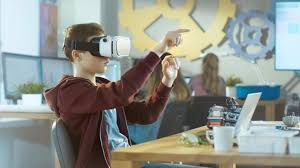Virtual reality (VR) has an opportunity to change how we educate and learn. Virtual reality (VR) can improve traditional methods of teaching and give students an exciting and enjoyable educational experience through the introduction of simulations, visualization, customization, collaboration, and engagement. We can anticipate seeing even more creative ways to use VR in teaching as it develops and becomes more widely available.

Aspects such as collaboration and communication between students and professors can be enhanced through VR. This technology allows students from all over the world connect in real-time to learn and discuss subjects in virtual classrooms. While giving students a sense of community, this can also provide them a global perspective. This is the true meaning of Global Collaboration right from the classroom!

Students can get a 360-degree picture of historical locations, archeological finds, and even space through VR. Difficult subjects can be explored and visualized by students in ways that traditional textbooks cannot. The universe can be explored in a virtual spacecraft, or students might go back in time to experience historical events. Students are more likely to remain focused and engaged by providing immersive and engaging learning environments. This may enhance learning results by increasing retention rates.
In a post made by Jaime Donally on 3/29 she listed a few places in which Explore by TimeLooper can transform the classroom into a whole new place!
- US History
- Civil Rights Movement
- World History
- State Parks
- WW11
- Animals
- Pre-Colonial/Colonial Era
- Government
- Nature
Check out this Youtube Video created by Jaime Donally with more details on Explore TimeLooper!
Thank you for reading!
Stay connect and follow me on twitter: @scullytstockedu